(In process of being edited 4/7/2011)
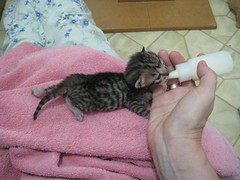
This page is split roughly into these sections:
- What you need
- Formula
- Feeding (long section, lots of parts)
- Videos
From birth until about 4 weeks or so, kittens are dependent on liquid nutrition. Normally, that would be mother’s milk, but sometimes kittens are abandoned, mothers do dry up for a variety of reasons, or you may find yourself with a kitten who is dependent on you for her nutritional needs.
You will need several things to formula feed an infant kitten:
- Bottle or syringe
- Formula
- Paper towel or toilet paper for pottying
- An alarm clock
- Patience
Optional but recommended:
- Digital scale that weighs in grams (you really want the level of detail you get using grams, when weighing an infant kitten. Ounces aren’t fine-grained enough for keeping track. That said, if that’s all you have, it’s probably better than nothing.)
- Spreadsheet or chart to record information
- Towels
First, NEVER feed a kitten cow’s milk or cream. They lack the enzymes to properly digest uncultured cow milk, and you will make them very, very sick, and probably kill them if you don’t get them off of it quickly. You have two choices:
- Buy kitten formula (powdered or premixed) from a pet store, vet, or grocery store. KMR is the most common one, but there are others.
- Make your own using a tried and true recipe.
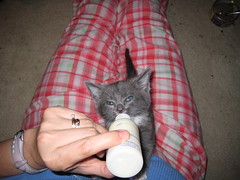 I make my own. I keep a bit of KMR on hand in case I have a kitten who shows up on my door and I can’t get to the store for the ingredients, but mostly, I always use my tried and true (and vet-approved!) goat’s milk based formula. It is WAY less expensive, WAY more calorie-laden (very good for tiny kittens), incredibly easy to make, and has saved kittens I was on the brink of losing more than once. I was actually losing a kitten when I decided to give this recipe a try for the first time, and it made all the difference. Since then I cleared it with my vet, and she’s sent people to me multiple times for the recipe.
I make my own. I keep a bit of KMR on hand in case I have a kitten who shows up on my door and I can’t get to the store for the ingredients, but mostly, I always use my tried and true (and vet-approved!) goat’s milk based formula. It is WAY less expensive, WAY more calorie-laden (very good for tiny kittens), incredibly easy to make, and has saved kittens I was on the brink of losing more than once. I was actually losing a kitten when I decided to give this recipe a try for the first time, and it made all the difference. Since then I cleared it with my vet, and she’s sent people to me multiple times for the recipe.
Goat’s milk kitten recipe (based originally from http://leerburg.com/bottlefeeding.htm which is a puppy bottle-feeding website):
- 10 oz. (1 1/4 cup) of goat’s milk (My local Lucky has it, but Trader Joe’s also has it.) Alternately, there may be evaporated goat’s milk near the evaporated cow’s milk. You can mix 10 oz of that with 3 oz of water instead.
- 1 egg yolk (I prefer organic, as I think it’s easier on their tiny tummies, but it probably isn’t critical. Actually, we have chickens, so I use our own eggs, but you get the idea.)
- 1 cup of plain whole (NOT low or non-fat) yogurt. They NEED the fat, don’t make a mistake with this! The yogurt can be cow’s milk-based. I’ve made this with greek yogurt, or cream top (be sure to stir it up first!), and whether the yogurt is thick, or soupy, it doesn’t much matter. Again, organic is nice, but not required. But do double check that it is both plain, and whole fat.
- 1-2 tsp light Karo syrup. If you have a new kitten, and you don’t know when they last ate, use 2 tsp in the first batch of formula. Once they’re settled in, and you make the formula again, 1 tsp is enough. (Honestly, I give a squeeze out of the bottle at this point, and don’t bother getting my measuring spoons sticky. They need it for their blood sugar, but it’s not a fussy measurement.) Do NOT use honey! Honey can carry botulism spores which they will not be able to fight, much like human infants.* If you can’t find corn syrup (I don’t know why you wouldn’t be able to – it’s EVERYWHERE, and certainly in most baking aisles) you can make a syrup up with sugar and water. Look on the ‘net for “corn syrup substitutes”
*Actually, to be more accurate, the problem with honey is that infant stomach linings allow for larger molecules to pass through to the blood stream, which allows for botulism to pass through. After weaning, the stomach lining changes, botulism can no longer be absorbed through the stomach lining, and will pass into the small intestine. Then the intestinal tract can take care of the botulism. That’s almost certainly unnecessary information: just don’t use honey. You can thank my physiology teacher for that bit of fascinating info.
That’s it! Stir it up well with a whisk, but try not to get it TOO frothy, especially if you’re going to feed it right away – you don’t want to fill your infant with air bubbles. Put this in a closed container, refrigerate it, and keep it no longer than a week. This fits pretty well into a normal sized water bottle, which also has a handy cap.
So now you have the food, how do you get it in the little tyke? This can be trickier than you’d think, until they get the hang of it. If you’re lucky, you’ll get a kitten who is hungry, and instantly latches on and gulps it down. Good on you, mate! Don’t count on that working at the 4 am feeding – I’m just saying! So what do you need to know to feed an infant kitten?
- Food temperature
- Bottle vs. Syringe
- Position for Feeding
- Amount
- Frequency
- Pottying
- Tracking Progress
- What to watch for/be careful of
- Aftercare
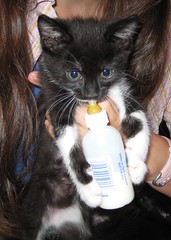
Food Temperature: Babies are tiny, and have a hard time maintaining their temperature through too many external or internal shifts in temperature, so you ideally want the formula to be pretty close to their body temperature (like mama’s milk would be.) Because I do this all the time, I have an automatic warmer for water, and I let the bottle sit in there for a short time, usually while I potty the baby before feeding. Never microwave the formula – you can get hot spots. Always check it against your own skin before feeding the baby. It should be warm to the touch, but not at all hot. If you can hardly feel it at all, it’s JUST shy of warm enough. Use some common sense here. You don’t want to chill the baby, nor burn her.
Bottle vs. Syringe
- Bottle:

If this is your first time, chances are you’ve already picked up one of those little nursing kits at the grocery store, pet store, or vet’s office. They come with a small plastic bottle, and a whole bunch of rubber nipples for different animals. These can and do work great, although you really have to be conscious about the type and size hole you make in the tip of the nipple. If you choose the bottle, make sure you start small with the hole, because you can always make it bigger, but you can never make it smaller. And a too-big hole can be dangerous. At my vet’s, they heat up a hypodermic needle and burn a nice round hole or two in the end, and that works great.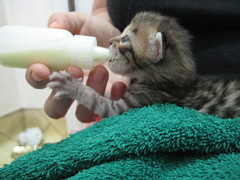 At home, I usually just cut a small X in the tip (which is usually what the instructions say to do anyway) and then check to see what the flow is like. You don’t want more than a very slow drip if you hold it upside down, but you do want it to flow easily with some pressure on the bottle. That’s what will make it safest for the kitten (no accidental inhaling of formula) and easy flow when she latches on and sucks. In the last year or so, I’ve given up on the nipples entirely, and just use the plastic tops I get that come with the 15 ml and 30 ml bottles I get from my vet. I find they have the perfect flow, they are easy to manipulate into a stubborn kitten’s mouth, and I don’t lose them when the kittens get older and try to steal them and run away!
At home, I usually just cut a small X in the tip (which is usually what the instructions say to do anyway) and then check to see what the flow is like. You don’t want more than a very slow drip if you hold it upside down, but you do want it to flow easily with some pressure on the bottle. That’s what will make it safest for the kitten (no accidental inhaling of formula) and easy flow when she latches on and sucks. In the last year or so, I’ve given up on the nipples entirely, and just use the plastic tops I get that come with the 15 ml and 30 ml bottles I get from my vet. I find they have the perfect flow, they are easy to manipulate into a stubborn kitten’s mouth, and I don’t lose them when the kittens get older and try to steal them and run away! - Syringe:
 Personally, for really tiny kittens, I always use a syringe. I have WAY more control if I need to help get the food in the kitten (just the tiniest bit of back pressure, and make sure she’s swallowing.) Also, I can tell exactly how much food the kitten is taking in, and in those first few days, this is really important. I also have found that the oral syringes have a tip shape that most kittens can latch onto easily, without it sliding out of their mouths while they figure it out. I usually start out with a 3 ml oral syringe.
Personally, for really tiny kittens, I always use a syringe. I have WAY more control if I need to help get the food in the kitten (just the tiniest bit of back pressure, and make sure she’s swallowing.) Also, I can tell exactly how much food the kitten is taking in, and in those first few days, this is really important. I also have found that the oral syringes have a tip shape that most kittens can latch onto easily, without it sliding out of their mouths while they figure it out. I usually start out with a 3 ml oral syringe.
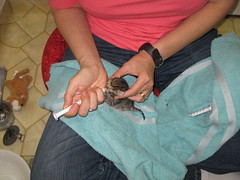 Position for Feeding: For tiny infants, you definitely want to make sure that they are belly down, with their heads upright, or even tilted up a little, paws typically outstretched in front of them. You will definitely have to help them position their tiny heads in relation to the nipple. I tend to cup their chin with the little finger of the hand holding the bottle. I sometimes also use my other hand to help steady their head until they get latched. When they get bigger (definitely not before their eyes are open) they sometimes get their own ideas, and then, all bets may be off. You are trying to simulate their natural feeding position, and also trying to avoid the baby aspirating fluids into their lungs. They can’t cough it back out like we can, so it’s a real pneumonia danger for them to do that. If they get a solid latch, you don’t have to worry at all – it’s only going down one way.
Position for Feeding: For tiny infants, you definitely want to make sure that they are belly down, with their heads upright, or even tilted up a little, paws typically outstretched in front of them. You will definitely have to help them position their tiny heads in relation to the nipple. I tend to cup their chin with the little finger of the hand holding the bottle. I sometimes also use my other hand to help steady their head until they get latched. When they get bigger (definitely not before their eyes are open) they sometimes get their own ideas, and then, all bets may be off. You are trying to simulate their natural feeding position, and also trying to avoid the baby aspirating fluids into their lungs. They can’t cough it back out like we can, so it’s a real pneumonia danger for them to do that. If they get a solid latch, you don’t have to worry at all – it’s only going down one way.
 If you see formula coming out their nose and/or bubbles, it’s not good – and it’s either going in too fast, or they’re getting some in the nasal passages. Stop, hold the kitten, gently, head pointing down, and tap lightly but firmly on the back, and hopefully anything that trickled into the lungs will come out. If I’m really worried that happened, I’ll usually put my mouth over their muzzle, and give a quick and gentle suck, too. But that’s me.
If you see formula coming out their nose and/or bubbles, it’s not good – and it’s either going in too fast, or they’re getting some in the nasal passages. Stop, hold the kitten, gently, head pointing down, and tap lightly but firmly on the back, and hopefully anything that trickled into the lungs will come out. If I’m really worried that happened, I’ll usually put my mouth over their muzzle, and give a quick and gentle suck, too. But that’s me.
Amount to feed: On average, a newborn kitten weighs 100-120g and should receive about 25-40 cc of formula per day for the first week or so of life. This should be ramping up throughout the week, and the kitten should take about 50-70 cc per day the second week, and 80-100 per day the third week. What is most important is to watch how the kitten is doing. Different kittens will take different amounts, and that’s okay – as long as they are steadily gaining, on average.
Frequency:  Kittens during their first week of life should be fed every 2-3 hours, around the clock. Yeah, the whole way around the clock.
Kittens during their first week of life should be fed every 2-3 hours, around the clock. Yeah, the whole way around the clock.
That’s the official advice for infant kittens. Some kittens won’t eat well at that frequency, even at the newborn stage, and may need a little longer between feeds in order to have enough interest to really get a good meal. If you have one of those, who isn’t that interested unless you wait for 3-4 hours, then follow her lead. But she still needs to eat the same amount per day, so pay attention!
If they’re going strong, then the second week you can probably stretch the night feeds to 3-4 hours between feedings, as long as you do the day feedings 2-3 hours. And never stretch it that long if they aren’t taking in enough throughout the day, or aren’t gaining weight. Again, if you have one of those kittens who prefer longer stretches, go with it, and lucky you! By the time they are three weeks old, you can usually get away with one middle of the night feed, and 4-5 feedings throughout the day.
Pottying: I usually potty the kitten before I feed, and then again after. That way I rarely get pee or pooped on by surprise. That said, remember I recommended towels? Yeah – they’ll always surprise you at one time or another (the towel is to protect you – not for the actual pottying!) Pottying is really pretty simple. I usually tear paper towels into quarters before I even get the kitten out of the box. When I have the kitten, I hold her, dip a corner of the paper towel into some warm water (or, actually, just give it a quick lick), and then firmly rub/stimulate her bottom until she starts peeing freely. With a bit of experience you can tell a lot from the color of the pee, and how much it soaks the paper towel (or toilet paper.) Ideally it’s pretty light or clear. If it’s very dark, it’s very concentrated, and you may have a baby who is getting dehydrated or having other issues. You want to make sure she’s pooping regularly, too, so don’t forget to stimulate her rear end, too.
Tracking Progress: I will tell you right now, if you don’t keep records and track the kitten’s progress, and your kitten takes a turn for the worse, you probably won’t know you’re in trouble until it’s too late, or almost too late to do something about it. 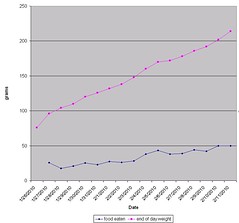 Keep records, and you’ll spot a problem quickly, and can maybe save the kitten. I have saved dozens of kittens this way, and I would NEVER not keep records. I use a simple spreadsheet, but paper and pencil works fine too. At a minimum you want to keep track of their inputs, outputs, and weight, and times of these. You are looking for a steady day-to-day gaining of weight (not feed-to-feed) with no more than one-day plateaus (I hate those, even though I know they sometimes happen!) Plateaus are okay if the kitten ate well the same day, and just probably had a couple of good poops. But still, start keeping an eye on input/output when the gaining makes a shift. The advantage to using a spreadsheet is the handy dandy charting functions!
Keep records, and you’ll spot a problem quickly, and can maybe save the kitten. I have saved dozens of kittens this way, and I would NEVER not keep records. I use a simple spreadsheet, but paper and pencil works fine too. At a minimum you want to keep track of their inputs, outputs, and weight, and times of these. You are looking for a steady day-to-day gaining of weight (not feed-to-feed) with no more than one-day plateaus (I hate those, even though I know they sometimes happen!) Plateaus are okay if the kitten ate well the same day, and just probably had a couple of good poops. But still, start keeping an eye on input/output when the gaining makes a shift. The advantage to using a spreadsheet is the handy dandy charting functions!
What to watch for and be careful of: While you’re feeding, you mostly just want to watch that your kitten isn’t aspirating, and that she’s latching on and getting her fill. 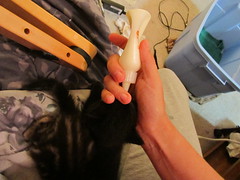 It’s actually better to be slightly underfed than overfed. Overfed babies can develop diarrhea which can become fatal pretty quickly from dehydration. Most of the time a kitten will latch on (once they have the hang of it) and get a good fast slurp down (I LOVE when they have such great suction that they collapse the bottle like in the picture here, or make the plunger in the syringe move on its own!), and after a quick burping and pottying, be ready to go back to sleep. Unless it’s your late night feed, in which case they will fuss about and refuse to latch, worry you silly, and FINALLY concede to taking in a measly 1-2 cc, making you wonder what you got yourself into. Yeah, that’s normal, try not to worry TOO much, as long as the rest of the feeds go okay.
It’s actually better to be slightly underfed than overfed. Overfed babies can develop diarrhea which can become fatal pretty quickly from dehydration. Most of the time a kitten will latch on (once they have the hang of it) and get a good fast slurp down (I LOVE when they have such great suction that they collapse the bottle like in the picture here, or make the plunger in the syringe move on its own!), and after a quick burping and pottying, be ready to go back to sleep. Unless it’s your late night feed, in which case they will fuss about and refuse to latch, worry you silly, and FINALLY concede to taking in a measly 1-2 cc, making you wonder what you got yourself into. Yeah, that’s normal, try not to worry TOO much, as long as the rest of the feeds go okay.
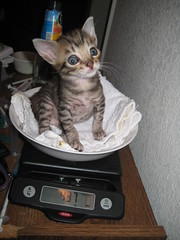 Kittens should approximately double their weight in the first week to ten days of life, with an average weight gain of 10 grams per day. If you’re charting, it’s going to be easy to spot things like weight gain, or lack thereof, more than a day or two without pooping, a large change in poop consistency, or a drop in feeding amounts.
Kittens should approximately double their weight in the first week to ten days of life, with an average weight gain of 10 grams per day. If you’re charting, it’s going to be easy to spot things like weight gain, or lack thereof, more than a day or two without pooping, a large change in poop consistency, or a drop in feeding amounts.
Aftercare: Baby kittens need burping just like human babies. It’s pretty simple – just a firm but gentle tap with one finger on their back, and usually a little gasp of burp will come out. If it doesn’t after a little tapping, you can let it go until next time. Some kittens don’t end up needing it. Always worth a try, though. Gas bubbles are no fun in tiny intestines! You should also potty your kitten after feeding them, so they have the best chance of staying clean and dry in their nest until the next feed. Speaking of their nest, check it and if it needs a new towel, take care of that before putting the baby back to sleep.
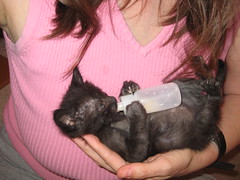
Naughty Kitten Eating the Wrong Way!









I was wondering if you could have a bit more on potty-ing and the importance of. I’ve only bottle-fed once and I remember this being the hardest part :).
That’s a good idea, thanks. Anything specific that you think should be there?
it sounds like you need both a towel (for your lap), possibly a towel for where the kittens are kept (to be swapped out before putting fed kittens back in their hangout) and paper towels for pottying … true? if so, the towels should be listed up top.
also … warm water for pottying isn’t listed up top. since you’re doing this in a bathroom, i think, this is easy for you to do on the fly but others may have different facilities.
More excellent comments – thanks!!!
re: tracking progress … can you show a good example and a worrisome example of the graph? you might want to link these in (instead of including the image on the page) if it distracts from the cuteness …
Great ideas! I have some of each, for sure! Thanks again!
i would like to know if what i saw is nornal?i have a cat who had newborn kittens and the kittens are 23 days old now,i saw poo on one of the kittens tail,so i got warm water on tolet paper and decided to wipe all the kittens.. after i was done,the tolet paper was all orange..what is wrong?are the kittens sick?
see post above..orange tolet paper after newborns were wiped,is that normal,or are they sick?
Pretty normal – it’s just poo smears, most likely
I have a 3 – 4 week old kitten that I have been bottle feeding for 5 days now (she’ll be 4 weeks in a couple of days). At first she was constipated, and I couldn’t ever get her to poop with stimulation. I’ve dried a liquid suppository, and have gotten (i’m assuming it’s a decent amount, since Kittens are so small) a medium sized bowel movement. But her stomach is so big and round! She eats between 20-40 cc at a time, around 4 times a day. (That’s her own schedule, I’ve tried less feeding more often, she cries continuously until I give her more). And she stops eating when she’s done. She won’t even open her mouth for more.
She plays with me for a few minutes after she eats, and then she falls asleep, and then wakes up again when she’s hungry again.
Is her stomach being so big normal? Is she just fat? What should I do?
The medium sized bowel movement was this morning, I’ve tried stimulating her again and nothing is happening other than urine. I just want to make sure I’m being good to her, and actually helping and not harming her. Thank you so much!
Lauren and Gilly (Like Jilly, but short for Gillian)
I have a similar problem. I have a kitten about 3-4 weeks old that I got 4 days ago. The mommy took the other kittens but left this one behind. It was outside crying all night and morning. It was a very cold night and I thought it would freeze out there. My neighbor took it inside and gave it to me to care for, ( I always take in the stray kittens when they are old enough so I can find them a home and get them fixed)
I have had the kitten for 4 days. It weighed about 11 oz when I got it and now weighs about 12oz. I have been feeding him the powdered kitten formula with a small amount of plain yogurt added. About 1tsp of yogurt, 8tsp of water, and 4 tsp of formula powder. He drinks about 3 to 4 oz of formula per day.
He has no problem urinating but he has not pooped. I tried rubbing him with a paper towel and he will pee but not poop. I am not sure what I should do. He appears healthy otherwise. He is active and loving.
I bottle feed a lot of kittens also (so far this year 2, with 7 still on the bottle). I use the Huggies natual baby wipes to potty my baby kittens. It holds together better than tolet paper and is already mosit.
I actually had the same problem too. I have 2 four week old kittens and I got them when they were almost 2 weeks old. They would NOT poop. Nothing was working so I finally just put their rectum area under the faucet and it worked! Make sure the water is warm- not too hot and not too cold. Like the temperature you would use for a baby and have a weak stream of water. Let the water hit their anal area and most likely they will pee and poop! Also rubbing the stomach with your index finger from the middle of the belly down will help as the water is hitting them. After make sure you dry them completely! Again make sure you dry them completely!
I have a question. I have a baby baby and i was feeding him and a bunch of the formula go up his nose. I did what your website said. He’s breathing ok. But I’m kinda worried. Is there anything else I can do?
He’s probably okay. Up the nose, in and of itself, isn’t a problem – it’s down the lungs that is. If you did what you can to keep it out of the lungs, then all you can do now is wait and see. If his breathing is okay, and he doesn’t develop a fever or weird breathing in the next 12-24 hours, you’re probably fine. You’re probably fine anyway, but I know how worrying it can be!
Help! I went to petsmart they gave me and recommended gnc formula it’s been 3 days but her ursine n body all together smells like fish…I went to get the ingredients for your formula but cannot find goats milk…u was gonna switch between ur formula and the gnc to see if it helps with the odor but I can’t find the goats milk.. She is only about a week old she was a stray the mom abandoned
I meant urine and I was gonna try your formula***
Thank you so much for this recipe! I’ve got a Queen who gave birth to 5 adorable kittens 2 weeks ago today. About a week ago, I found an abandoned litter (strays are a huge issue in my area) of 8. Boo (my Queen) has adopted them beautifully, but I’ve also been bottle feeding them all so as to not overburden her. Went to the grocer for more kmr and they had none, and I’ve got hungry babies. I’m going to blend some up soon and give it a go. I think they’ll actually like it better!